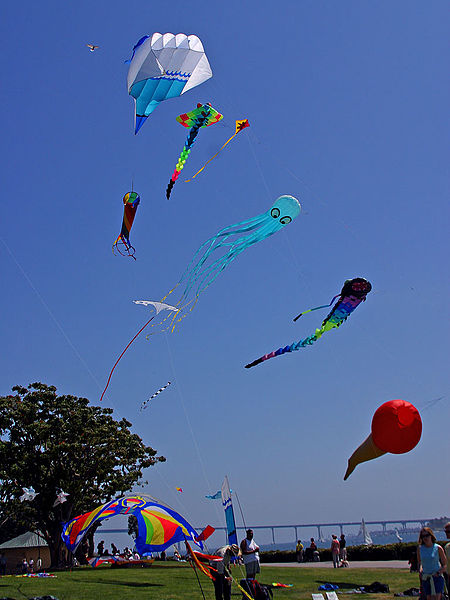
Kites: History, Aerodynamics and Uses
As with paper airplanes, we have Chinese inventiveness to thank for another wildly popular aerodynamic device – the kite. Kites have evolved over millennia to the extent that they can now provide useful motive forces to aid ships to cross oceans. However, their ability to thrill children (and those young at heart) with their grace and aerobatics remains intact.
 Kites in FlightCourtesy of Jon Sullivan
Kites in FlightCourtesy of Jon Sullivan
Brief History of Kites
There's some debate as to whether the first paper airplanes were actually kites or vice versa, so it seems they were both initially entwined (pardon the pun). Early Chinese kites consisted of a bamboo frame covered in paper, hence the paper airplane debate. Another, more robust, covering often cited in relation to early kites was silk, though presumably at considerable expense.
Kites have found many uses beyond their pure entertainment value. Early Chinese kites were used to measure distances, determine wind strength, and communicate. Their contribution to scientific and technological advances is also considerable. For instance, Benjamin Franklin's discovery that lightning is caused by electricity is attributed to a kite-flying experiment he performed in 1752 during a thunderstorm. The Wright brothers also used kites to perfect their airfoil designs and flight control system (wing warping) prior to their historic first powered flight in 1903.
Kite Aerodynamics
A kite's aerodynamics is similar to that of a flying wing. The primary concern in kite design, as with all aerodynamics devices, is to ensure adequate lift to counter its weight. Drag and excess lift are secondary considerations as they can usually be countered by the operator on the end of a control line.
The lift generated by a kite is determined by its shape and inclination (angle of attack) to the wind. In flight the kite surface is forced upwards due to the pressure difference across the thickness of its surface. This pressure difference is the source of the kite's lift. The shape the surface forms, while in flight, determines is aerodynamic efficiency (lift/drag ratio). A single surface, as in most simple kite designs, is sufficient for having fun. However, if you want to generate serious lift, say to support a person such as a paraglider, then a more efficient kite is needed. Such a kite is known as a parafoil, which uses an opening on the upwind edge (leading edge) of a two-surface fabric wing that inflates to form a true airfoil section when in flight. The airfoil-shaped kite produces a much improved lift/drag ratio compared to the single surface kite.
Simple kites have a single control line which requires a symmetrical design and a well positioned control line attachment position to enable stable flight. Stunt (or sport) kites may have 2 or 4 control lines, connected close to the extremities of the kite, to permit control in vertical and horizontal directions.
Novel Kite Uses
Improved kite construction materials, such as carbon fiber for structural spars and ripstop nylon, have permitted kites to grow in size. Larger kites (known as traction or power kites) incorporating the latest parafoil designs have encouraged novel and new uses such as kitesurfing or kiteboarding.
Kitesurfing
A promising solution for saving fuel in ocean-going vessels is under development by KiteShip. Using a large power kite deployed from a boat as needed and when conditions allow, KiteShip aims to provide an environmentally friendly means to reduce fuel consumption at sea. Their kite concept won the Transportation Category in the 2006 California Clean Tech Open.
Kite Air Flow Simulation
The primary focus of kite design is on producing lift. Also a kite is typically a streamlined shape, which makes it an ideal candidate for in-flight simulation using a panel method such as our Caedium Panel Flow add-on. If you are interested in designing kite shapes from scratch and analyzing their performance under transient conditions (such as during stunts) then consider our Caedium Professional add-on.
- Richard Smith's blog
- Login to post comments
Select Language
Recent blog posts
- CFD Simulates Distant Past
- Background on the Caedium v6.0 Release
- Long-Necked Dinosaurs Succumb To CFD
- CFD Provides Insight Into Mystery Fossils
- Wind Turbine Design According to Insects
- Runners Discover Drafting
- Wind Tunnel and CFD Reveal Best Cycling Tuck
- Active Aerodynamics on the Lamborghini Huracán Performante
- Fluidic Logic
- Stonehenge Vortex Revealed as April Fools' Day Distortion Field


Comments
SkySails
SkySails is another company, like KiteShip, developing a large power kite for ships. They claim that their kite will reduce annual fuel costs by 10-35%. SkySails won the Best Product Innovation category at the Zukunftsaward 2007 (Future Award 2007). Seems that ships and kites are a winning combination.